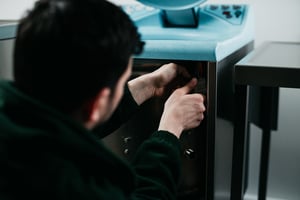
Cleaning and Maintenance Tips for Long-Lasting Sluice Room Equipment
In the healthcare industry, the importance of maintaining high standards of hygiene and compliance cannot be overstated - especially in critical areas like the sluice room.
The sluice room is where medical equipment such as used bedpans and urine bottles are processed. Depending on the facility’s needs, these could be pulp items which are fully disposed of – or re-usable items that are cleaned and disinfected.
Regardless of which strategy is used, every hospital and care home must dispose of human waste in the most hygienic way possible. The most reliable way to do this is by using specialist sluice room technology, such as a pulp macerator or bedpan washer disinfector. When paired with robust infection control procedures, clinicians can be confident that both they and their patients are protected from the spread of dangerous pathogens.
In order to keep essential equipment working at its optimum, proper cleaning and maintenance is vital. This will not only ensure a hygienic environment, but also prolong the life of critical sluice room machinery – allowing facilities to reduce the cost, inefficiency and risk associated with unexpected breakdowns.
Maintaining hygiene and ensuring compliance
Keen to keep your sluice room equipment functioning efficiently for years to come? Here’s our tips…
1. Regular Cleaning is Key
As a guide, you should always…
- Follow Manufacturer Guidelines. Every piece of equipment comes with manufacturer recommendations for cleaning. Adhering strictly to these guidelines ensures that the equipment is cleaned effectively without causing damage.
- Use Appropriate Cleaning Agents. Select cleaning agents that are both effective against pathogens and safe for the equipment at hand. Harsh chemicals can damage machinery over time, leading to costly repairs or replacements.
- Focus on High-Touch Areas. Frequently touched surfaces on the equipment should be cleaned more often to prevent the spread of infection. This includes handles, buttons, and control panels. Some machinery – such as DDC macerators and washer disinfectors – are equipped with an extra layer of defence, such as antimicrobial surfaces, as well as a reduced touch points aided by hands-free technology.

2. Don’t Forget Scheduled Maintenance
Sluice room machinery must be proactively maintained to keep it in good condition. Waiting for equipment to break down before investing in maintenance will result in unnecessary expense, inconvenience and danger of infection outbreaks.
Well-planned maintenance should include…
- Daily Inspections. Quick daily inspections can catch minor issues before they escalate. Look for signs of wear, leaks, or unusual noises that could indicate a problem.
- Regular Servicing. Schedule regular servicing as per the manufacturer's instructions. Professional servicing ensures that every part of the equipment is functioning correctly and can help identify issues that may not be immediately apparent.
- Keep Maintenance Records. Document every cleaning and maintenance activity. This not only helps in keeping track of the equipment's health but also is crucial for compliance purposes.
3. Addressing Wear and Tear
Even with maintenance, machinery will experience wear and tear over time. There are still ways to manage this effectively, however.
- Replace Parts Promptly. If a part is wearing out or malfunctioning, replace it immediately. Delaying can lead to more significant issues and might even cause the equipment to fail.
- Train Staff Fully. Proper training for staff on the correct use of equipment can minimise unnecessary wear and tear. Misuse or overuse can also shorten the lifespan of the machinery.
- Be Proactive with Upgrades. By staying up to date with technological advancements, as well as upgrading parts or software, efficiency and lifespan of equipment can be enhanced.
4. Handling Breakdowns
With a maintenance plan in place, unexpected breakdowns should be a rarity (assuming staff are well-trained and using machinery appropriately). If a breakdown should occur, it’s important to handle this scenario with care, to prevent greater damage and infection risk.
- Have a Contingency Plan. In case of a breakdown, have a plan in place to handle waste and cleaning without the equipment. This might involve using alternative facilities but should avoid manual processes, such as washing bedpans by hand.
- Seek Professional Repairs. Always use professional repair services for any equipment issues. DIY fixes might seem cost-effective but can lead to further damage or void warranties.
- Review and Learn. After a breakdown, review what went wrong and how it was handled. This can provide insights for preventing future issues.
5. The Role of Training and Awareness
You should conduct regular training for staff on the correct operation and cleaning of equipment. This includes keeping everyone updated on any changes in procedure or equipment.
- Promote a Culture of Cleanliness. Encourage a workplace culture that prioritises cleanliness and proper maintenance. When staff understand the importance of their role in maintaining equipment, they are more likely to follow best practices.
The longevity and efficiency of sluice room equipment largely depend on regular cleaning, proper maintenance, and the prompt addressing of wear and tear.
By implementing these practices, healthcare facilities can ensure a high standard of hygiene and compliance while maximising their investment in sluice room equipment.
Remember, in healthcare, the safety and wellbeing of patients and clinicians alike depend on these vital behind-the-scenes efforts.
VIEW OUR FULL RANGE OF SLUICE ROOM SOLUTIONS
LEARN MORE ABOUT SLUICE ROOM REFURBISHMENTS








